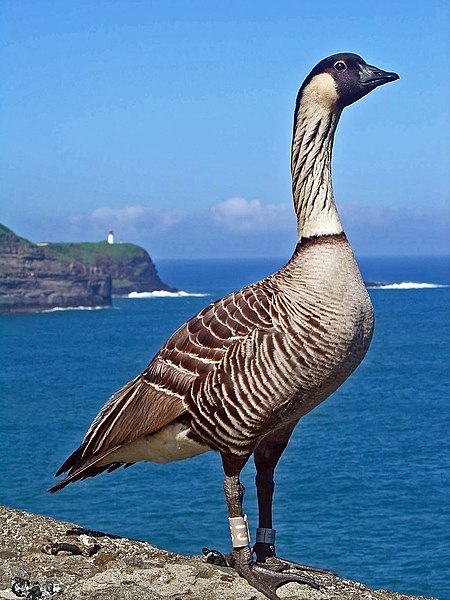 As regular CFZ-watchers will know, for some time Corinna has been doing a column for Animals & Men and a regular segment on On The Track... about out-of-place birds, rare vagrants, and basically all things feathery and Fortean.
As regular CFZ-watchers will know, for some time Corinna has been doing a column for Animals & Men and a regular segment on On The Track... about out-of-place birds, rare vagrants, and basically all things feathery and Fortean.
Because we live in strange times, there are more and more bird stories that come her way, so she has now moved onto the main CFZ bloggo with a new column with the same name as her aforementioned ones... Rare geese win race to hatch first
Hawaiian geese, or nenes as they are commonly known, happily feed from visitors’ hands and thus are a popular bird at Slimbridge Wetlands Centre in Gloucestershire. They are a rare species of goose (their numbers dropped dangerously close to extinction in the 1950s) and this year have become the first to have hatched their young at the centre. However, with temperatures still chilly at night, the families are moved to the centre’s duckery for a couple of weeks before being released back into the main grounds.
Phoebe Young, Duckery warden, said: "The Nenes hatch their first goslings from as early as February every year in correspondence with their natural southern-hemisphere season.

Despite acclimatising to UK weather, they still prefer to hatch their young in association with their wild counterparts on Hawaii. The families are protected from night time chills within the off-site Duckery area for two to three weeks, but will be back in the grounds in time for the Easter holidays ready to greet our visitors!"
From Saturday 31 March to Monday 15 April visitors will be able to meet the nenes in a specially designated area, follow a trail to learn more about them and make their own goose in our discovery centre.
Phoebe added: "Our regular visitors love the Nenes so we are excited about having lots of activities themed around them. If you have never met the rarest goose in the world, now is your chance!"
To find out more visit our website at
www.wwt.org.uk/slimbridge and Phoebe’s blog on the Slimbridge main page.
http://www.stroudnewsandjournal.co.uk/news/9596031.Rare_geese_win_race_to_hatch_first/ELUSIVE yellow-browed warbler
Rare warbler has twitchers flocking together
Although the yellow-browed warbler usually migrates from Siberia at the beginning of winter one was spotted in the yard of a house in Warndon Villages, Worcestershire recently, and it is thought that the tiny rare bird may have wintered in Britain.
For Tony Wilmore, of Hastings Drive, Warndon Villages, it was the twitchers themselves who were well worth watching. He said groups of them had flocked to the old Tolladine Road area for a glimpse of the bird.
“I was walking my dog on Saturday morning and there were all these chaps with big cameras, and pairs of binoculars hanging around their necks,” he said.
“I said to my wife ‘I don’t know about that film Day Of The Triffids, it was more like day of the twitchers in Warndon’.”
A Worcestershire Wildlife Trust spokesman said the bird was “tiny, very pretty and highly elusive” so to have one in the city was a treat. “I think the last time we may have seen one of these in Worcestershire was at Upton Warren, near Droitwich. They’re not very common,” she said.
• Do you have any pictures of the yellow-browed warbler in the county? Email them to
news@worcesternews.co.ukhttp://www.worcesternews.co.uk/news/local/9588968.Twitchers_flock_together_for_rare_warbler/Nature reserve near Souter Lighthouse
A nature reserve for wild birds is nearing completion near Souter Lighthouse in Whitburn. The South Tyneside Coastal Conservation Group (STCCG) project will consist of two wildlife ponds filled with water for the first time in more than ten years, and it is hoped that they will attract rare birds to the area. There will also be a feeding station for birds, complete with viewing hide and information point.
The National Trust run Souter Lighthouse and STCCG have been overseeing the project with their help. Steve Egglestone, one of the group’s volunteers, said: “A lot of work has taken place over the past few weeks and it really is starting to take shape.
The lakes have been lined and we had hoped they would have been filled with water now. There hasn’t been enough rain for that, but we will look at other ways of doing this. We have a beautiful stretch of coastline here and this will be a welcome addition.
Hopefully, it will be a place for birds to thrive and also a relaxing environment for people to come and watch and learn about nature. We want it to attract rare birds to the area, and also help to bring more visitors to South Tyneside.”
Nick Dolan, National Trust property manager, said: “More places of interest on the coast can only be a good thing, giving more reasons for people to enjoy the outdoors and get closer to nature.”
http://www.shieldsgazette.com/news/local-news/nature-reserve-is-flapping-marvellous-1-4342333
 The hunt for British Big Cats attracts far more newspaper column inches than any other cryptozoological subject.
The hunt for British Big Cats attracts far more newspaper column inches than any other cryptozoological subject.











